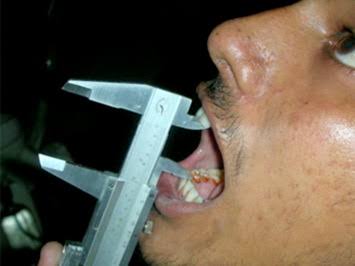OSMF is a disease of the mouth in which the inside of the cheeks and mouth becomes tight, stiff, and difficult to move. It happens because the soft tissues inside the mouth start to harden (this is called fibrosis).
Common Causes:
• Chewing areca nut (supari) – very common in India and Southeast Asia
• Chewing tobacco
• Spicy foods (sometimes can irritate more)
• Nutritional deficiencies (like low iron or vitamin B)
• Genetic or immune problems (in rare cases)
WHAT PATIENTS COMPLAIN ABOUT
• Burning feeling in the mouth, especially when eating spicy food
• Mouth feels tight or hard to open
• Stiffness in the cheeks
• Pale or white patches inside the mouth
• Ulcers or pain sometimes
• Dry mouth
Surgery is Recommended in OSMF:
1. TWO FINGER OR LESS MOUTH OPENING
o Interincisal mouth opening <20 mm.
o Severe fibrous bands, especially in the buccal mucosa, soft palate, or retromolar area.
o Difficulty in eating, speaking, or oral hygiene maintenance.
2. Fibrous Band Formation with Severe Trismus:
3. Presence of Ulceration or Suspicion of Malignancy
4. Failure of Medical Treatment
5. Psychological or Functional Impairment
TYPES OF SURGERIES
o Fibrotic band release with or without
Buccal fat pad graft.
Skin or mucosal grafts.
Tongue flap or nasolabial flap reconstruction.
o Coronoidectomy if needed (to improve mouth opening).
o Laser-assisted fibrotomy (in some cases).
Surgery is Not Recommended in OSMF:
1. Early or Mild Cases (Grade I or II)
2. Ongoing Areca Nut or Tobacco Use
3. Uncontrolled Systemic Illness
4. Active Oral Infections or Ulcerations
5. Patient Non-Compliance or Poor Follow-up Potential
| OSMF Grade | Mouth Opening | Surgery Indicated? |
| Grade I | >35 mm | ❌ No |
| Grade II | 26–35 mm | ⚠️ Maybe (if progressive) |
| Grade III | 15–25 mm | ✅ Yes |
| Grade IV | <15 mm or with dysplasia | ✅ Yes |
Oral Submucous Fibrosis (OSMF) is a chronic, progressive condition affecting the oral cavity, often linked to the use of areca nut and tobacco. This blog explores the causes, symptoms, diagnosis, and treatment options for OSMF, highlighting its potentially malignant nature. It also discusses preventive strategies, lifestyle changes, and the importance of early detection to manage the condition effectively. Whether you’re a healthcare professional, student, or someone looking to understand more about this condition, this blog offers clear insights into one of the most serious oral health issues prevalent in South Asia and beyond.

